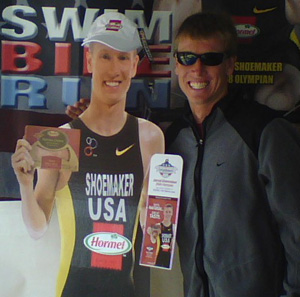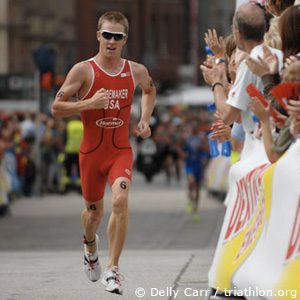America’s top man in ITU racing
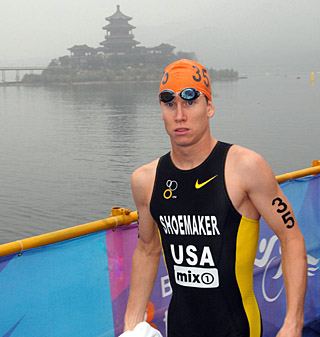
American men in the ITU short course, non-drafting, Olympic-style have risen from also-rans in the mid-1990s to contenders for greatness in this decade. Led by Hunter Kemper, Andy Potts and Matt Reed, American men keep knocking on the door. Consider Hunter Kemper’s ITU World Cup number 1 ranking in 2005, Andy Potts’ Number 3 season ranking in 2006, and Matt Reed’s World Cup series charge to gain the points that put three American men into the 2008 Olympics.
And yet, despite Kemper’s four victories and Andy Potts’ three wins in ITU World Cup combat, and Matt Reed’s second place World Cup finish in the heat of his 2008 campaign, no American male has won gold at the ITU Olympic distance World Championship since Mark Allen in 1989 and no American man has won a medal of any kind at the ITU Olympic distance World Championship since Mike Pigg’s third place at the 1991 ITU Worlds.
Right now, America’s Big Three in ITU World Cup, short course triathlons have wider interests than the hyper competitive, pure Olympic-style racing. Kemper has won non-drafting big paydays at Life Time Fitness and took a prestigious win at Escape From Alcatraz – but he is also out of action, recovering from an old hip injury. Potts has ruled Escape From Alcatraz, won an Ironman 70.3 World Championship and his entry at this year’s Ironman World Championship is eagerly awaited since his 7th place finish last year on virtually zero long distance training. Matt Reed has shown that he can swim, bike and run with the best in the world in both draft-legal and non-drafting venues and seems to be taking dead aim on the Ironman 70.3 Worlds this year. But his 5th at the ITU World Championship in 2008 remains the high-water mark for current U.S. men in World Championship and Olympic level competition.
In 2009, as the international fields have become faster and deeper, another American man has become a prominent player in the ITU world. Jarrod Shoemaker now stands 5th in the new ITU World Championship points series. Just before turning 27 years of age, Shoemaker just won the Hamburg round of the Dextro Energy World Championship series. Thanks to hard-earned improvement in the swim, previously a crippling weakness in ITU racing, Shoemaker has been able display a run that stands among the very best in an increasingly swift-footed group of runners.
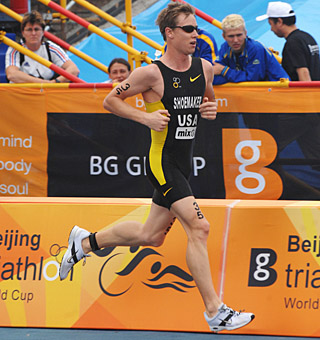
Consider the facts: In two ITU World Cup events and five ultracompetitive World Championship series races in 2009, Jarrod Shoemaker has had the fastest run split twice, the second-fastest run three times, and recorded the third-fastest run once. Those run splits varied from a slow 31:32 at a tactical race at Hy-Vee to a 30:49, a 30:36 and a 30:28 at reasonably accurate 10ks at Madrid, Tongyeong, and Washington D.C., plus a race-best 29:37 at Hamburg [which has proven to be 200 to 300 meters short.] During this string, Shoemaker has out split the likes of World Champions Javier Gomez and Bevan Docherty, multiple World Cup winners Brad Kahlefeldt and current ITU sensation Alistair Brownlee, Olympic champions Jan Frodeno and Simon Whitfield,
Of course, Olympic style triathlon is three disciplines, and despite his improvement on all fronts, Shoemaker is still learning swimming, biking and run strategy. This shows in Shoemaker’s overall finishes: 8th at Ishigaki, 6th at Tongyeong, 12th at Madrid, 8th at Washington D.C., 5th in a six-man, last-lap shootout at Hy-Vee, a DNF in freezing rain at Kitzbuhel, and his impressive, hard-earned win at Hamburg.
While the run has become the key to ITU World Cup-World Championship series victory, pure 10k speed needs to be mixed with canny, mid-race strategy. Like Javier Gomez, Shoemaker does not have the final 100-meter sprint speed of Frodeno, Whitfield, Docherty, Brownlee and Kris Gemmell. Hence Shoemaker’s fade to 5th (and Gomez to 6th) in the six-man duel to the line at Hy-Vee. Having learned his lesson about waiting for the end in a strategic race at Hy-Vee, Shoemaker blazed all the way at Hamburg and left Kahlefeldt and other contenders in his dust for a prestigious win against a group of top-tier Germans on their home court.
By focusing strictly on the ITU circuit and learning its intricacies, Shoemaker thus has emerged as America’s best bet for a men’s ITU World Championship series medal this year.
Shoemaker shared his thoughts about the 2009 season with Slowtwitch in an interview prior to the rollout of 2012 Olympic course at the Dextro Energy World Championship Series round six August 16 in London.
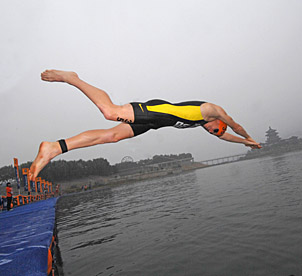
On his improved swim
In my triathlon career, I have had some good swims and bad swims. The good ones set me up for good races. So I really worked on biomechanics and form this offseason to get more power out of each stroke. Over the winter I worked with coach Rich Axtell at Team Minuteman Masters on several things. We did a lot of stroke work. And we also did a lot of work thinking about races and how they unfold and how best to train for them. One key element was to really set up a plan for the whole swim. You don’t just go out and swim 1500 meters as hard as you can. If you fire off at the start and race blindly, you expel more energy and waste energy going around buoys. You need to swim with your head up and then accelerate again when things open up.
It’s one of those things when you learn how to do it you understand it. It is not about swimming hard. It’s about swimming smart. I tell friends you have to shoot the gap and take off when you see the opportunity. It’s like riding a horse in the Derby. When you see a spot open on the rail you take it. When the way is blocked, you can sit behind, thinking: OK, I will rest. I will wait patiently until things open up. Then I will have acceleration and power when I need it to pick up speed and settle in and establish a faster pace.
I felt like my training was going good all winter long through March and April. But it is hard to get an indication in the pool or open water swimming with friends just how you will perform in a race. I think at Ishigaki [in his first race of the season] I was surprised how well I swam and how good I felt through the whole swim. In the past, I would feel good one lap, and then fade. This time I picked off spots the second lap.
How he won his 2005 U23 World Championship title
I had a pretty bad swim there too. But that bike course was flat, fast and hot and the bike slowed down and the field got all packed up. Obviously, it is better to come off the bike near the front and stay out of trouble. While I could not afford to do that at the Olympics three years later, in 2005 I was one of the best runners in Under 23 and I came off towards the back and then I ran through the field. That is one of those things there are two ways you can look at it. One, if you give someone a lead off the bike, they have a lead and you have to work to get it back. At the same time, if the run is your strong suit, I would rather run at a faster speed than put extra effort on the bike. Triathlons are an overall energy equation. Of course it is better to be at the front of a big bike pack, and if the chance is there you take it. But in 2005, I had the run to get the job done. In 2005, the guy I passed for the win was Danylo Zapunov of the Ukraine, who is still racing great today.
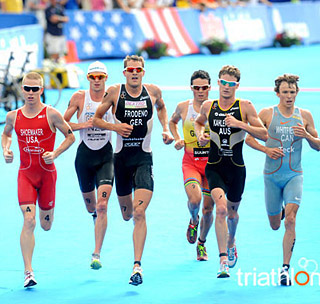
First race of 2009 – Ishigaki World Cup
I got out of the water at Ishigaki in 17:17, 14th position and 36 seconds off the front. I just missed the front group of the chasers. Those guys in the front pack got a huge gap on our group and stayed away. So I dragged myself into the 8th position with the second-best run [31:03] and finished 8th.
First World Championship Series race of 2009– Tongyeong, South Korea
Next weekend in Tongyeong was an eye opener for me that showed my work on swimming was paying off. Before, I always had problems swimming in a wetsuit. But this day I was third out of the water [in 18:11] That also helps build confidence, having good swims with regularity.
In Tongyeong all the cyclists came together, which was fine with me. I felt awesome and had a lot of energy starting the run and went into the lead. Then I got a side stitch and fell back to 10th or 11th. But on the last lap I came good again and ran back up to 6th. [In Tongyeong, Shoemaker ran a third-fastest 30:36].
Second World Championship Series race – Madrid, Spain
I did not have quite as good a swim in Madrid and came out of the water 24th, 39 seconds back. In terms of the swim, it was not a big deal at all. I felt good in the swim but I lost someone’s feet. On the bike I was in a chase pack of 10-11 guys but somebody in our group let the breakaway group get a gap and they kept going. On the run, I was right with Jan Frodeno [2008 Olympic champion] and Brad Kahlefeldt [2nd at Tongyeong] in the last 300 meters. I felt good because I was running with the best runners in the sport. At the finish we came up on two other runners and I got outsprinted and finished 12th. [Still, Shoemaker recorded a 30:39 10k, second-fastest run 18 seconds slower than winner Alistair Brownlee].
Third World Championship Series race – Washington D.C.
[In this race, Alistair Brownlee, Javier Gomez, Maik Petzold, Andy Potts and Hunter Kemper got a small gap on the swim and then broke away on the bike, leaving the chasers 2 minutes back starting the run]
What happened was those guys were working together but our guys were not working. It definitely was a frustrating race. I knew I was in good shape and I would have loved to have been on podium in D.C. and felt like I could have done it. When we got out of the water, the gap was 20 or 30 seconds and we should have caught them. But certain people in our pack weren’t interested.
The thing was in many of those earlier races I did a lot of work in those packs. In Washington DC, the last few laps of the bike I tried to take back a few seconds and get the gap down to 1:30 so I could have a better shot at catching Andy and Hunter.
I remembered in a lot of earlier races I had done a lot of work up at the front of the run. After one lap, I tried to get the tempo up, and while doing that I burned off some steam. So then I backed off and tried to fit back in the pack, recover a bit, then go again. Any time you are at the front running, although not as much as in the bike, other people definitely can draft off you. The other side of the coin is if you sit in pack, you do not run as fast as you can individually. You get complacent and drop into a tempo pace.
Finally, Jan Frodeno surged halfway through the run and Laurent Vidal put in a long kick and both of them got me at the line and I took 8th. [Shoemaker’s 30:28 run was second to Frodeno’s race-best 30:26 and faster than Vidal’s third-best 30:29. All of them ran faster than winner Alistair Brownlee’s 31:00 run, but they had lost the race on the bike]
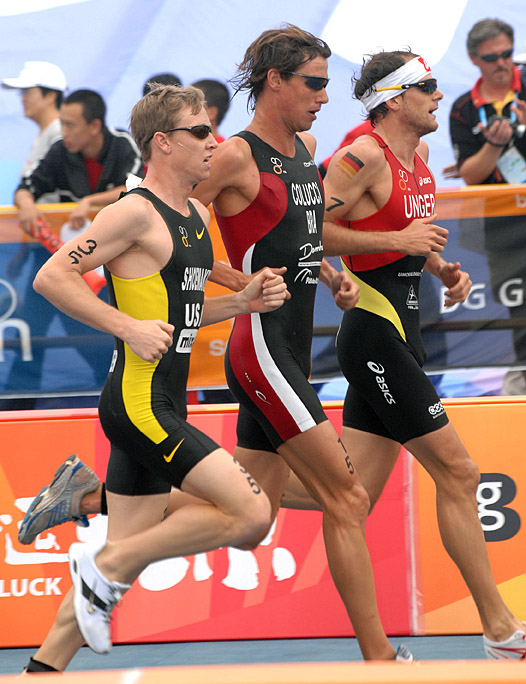
Lessons learned in the $200,000 duel at the Hy-Vee World Cup
I had an awful swim. At the first turn buoy, there was a little chaos so I went wide and ended up going a long way past. There were so many people who got to the buoy at the same time, they were 10 wide. It was more than a 90-degree turn around the buoy so I ended up losing even more time. I was almost last after the first lap of the swim, but at same time, with the confidence I got from previous races, I believed I could pick things up. On the second lap, I thought about what Simon Whitfield said after a bad first lap in the swim at Tongyeong: “My race is not over. My race is now to see how I can pass as many people as possible on the second lap.” That was all I thought about at the time – to pass as many people as possible. When I came out of the water, I think I was about 30th and trailed by about 15-20 seconds starting the bike.
We did a lot of chasing on the bike in that race. My pack worked really hard and I think Bevan [Docherty] and Clark Ellice and I were about a minute back of Matt Reed and Stuart Hayes and a couple seconds back of the main chase pack starting the run. [Tim Don and Danylo Sapunov were also ahead of Shoemaker, 20 seconds back of Reed and Hayes, but were also run down]
Off the bike, I think I was one third of the field off the lead. I think the fast guys caught those lead guys about 1k into the run and we had the lead before the first of four laps. Then I just stayed with [Gomez, Whitfield, Kahlefeldt, Gemmell and Frodeno] at a very high rate of speed.
After the race, I was not happy with myself. Looking back, Simon Whitfield actually went off the back a few times, but nobody made a move to drop him out of the front pack. Nobody made a move to win, and after two laps, the pace actually dropped. We were definitely slower the last two laps.
With a few hundred meters to go, I was ready to go on a sprint and I tried to go inside on one of the final corners, but I got pinched off and boxed out. And then they were gone. I think was ready to go but I don't know if I would have been able to sustain the sprint speed the guys had because I had lost so much momentum.
One thing I learned was that those guys can sprint really fast, faster than it looks. Later it mentally frustrated me to realize that in order to win I could not sit there and hope something happens. I realized that with a mile to go, I needed to make a long hard surge.
Still I came away with good feelings. The big thing I took out of it was that I had another great race and I was consistently running with the best guys in world in our sport. I was running with men who won two Olympic gold medals [Whitfield placed 1st at Hy-Vee and won Olympic gold in 2000 and Frodeno was 3rd at Hy-Vee and won Olympic gold in 2008], and Kahlefeldt [2nd] and Kris Gemmell [4th] have won lots of races and made tons of podiums. That to me was another important confidence builder.
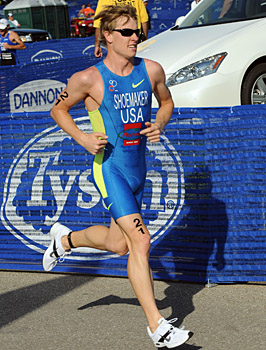
World Championship Series race four – Kitzbuhel
I raced Kitzbuhel and had an amazing swim [15th, 23 seconds off the lead swimmer] there and I got out in the front pack. But it was freezing and raining and I was so cold and I was shivering so much I could not control the bike and I dropped out and it frustrated me. That race Brownlee and Gomez fought it out and Brownlee won and Gomez was 2nd. I really look forward to going against those guys.
World Championship Series Race 5 – Hamburg
I had not even planed to race there. But I ended up staying in Kitzbuhel and trained there for a week and a half. Basically I had very tough, really hard training. I wanted to push myself and going into that race I had great run workouts and I felt really good. On race day it was raining for the girls but by the time we raced, the weather was gorgeous, in the 70s and sunny. And Hamburg with all people there is an amazing venue to race.
I was disappointed that Brownlee and Gomez did not race Hamburg. But the Frodeno and Kahlefeldt were there and the Germans were all good, all inspired on their home course. Maik Petzold was going very well [4th at Madrid, 3rd at Washington D.C., 4th at Kitzbuhel] and [2007 ITU World Champion] Daniel Unger won Hamburg two years in a row.
I did not get a good start on the swim and I was maybe 40th at the first buoy. Halfway back to the turnaround point on the first lap, I recognized that I had an opportunity to pick off places on that long straight and I swam back up to 15th and I stayed in that position [31 seconds back from the lead] coming on to the bike.
There was a little separation in transition and I missed the first [pack]. I wished I had gotten on. Our group chased the front pack for a lap and a half, then we finally caught back on. The pace was not extremely hard for the first few laps. Hamburg is a very technical course with many sharp corners and the pack lengthened out into a long line and I ended up sitting in at the back. Normally that is a little too far back. But on that bike course, if you are not all the way up by a mile and half to go, you cannot make it back up. There is no room to pass. I remember [fellow USA competitor] Kevin Collington came back and asked me I how was feeling. I said “Don’t worry about me. I’m having fun and I’m feeling good.” I knew I had trained so well, so consistently, I had confidence I’d run fast regardless. The last lap of the bike, I probably worked one third of the way through the field and I came off the bike in what seemed like 40th place.
I set off running in the middle of the pack and by the end of the first lap I caught the leaders of the chase — Brad Kahlefeldt, Jan Frodeno, Steffen Justus and Maik Petzold – and had only three of the breakaway riders in front of me. I knew the three started the run with about a 90-second lead, and in most races you can run them down. At the same time, it is what it is. There is not much you can do except run as hard as you can. The second lap I just kept going hard and caught Christian Prochnow and Paul Tichelaar right at 5km. When I caught up to those guys, I made a decision to keep going and not sit in run with the pack.
At that point I just continued to push. To some extent when you are out front, the tendency is to relax because you are out by yourself. So I knew not to hold back. Don’t go too hard, go smart, strong and smooth. Also, I kept getting information that I had a pretty good gap.
Once in the lead, I don’t usually look back. At the roundabouts I could see if I had increased the gap on the people I had passed or if they were coming closer. This was all stuff I learned from running races — how to pace myself and how to know when you really need to put out the effort. I felt great, but I tried to keep the thought ‘Oh my I will win it’ out of my head. That can lead to disaster. A few hundred meters from the finish I looked once to make I sure kept strong all the way in. Finally, I flipped off my sunglasses for the finish.
Looking forward to London
Racing in London, it will be the first Olympic course preview and I am excited to race Brownlee [a perfect three wins in the World Championship series] and Gomez [two seconds and a third] there. The past two times I raced against Brownlee, we were not in the same pack and in Kitzbuhel I dropped out with hypothermia. I want to be in the game with him. That is what anybody would have to want – to push themselves against the men who have proved to be the best athletes right now.
My goal is to race well but I don’t think I can win every time. If anyone says they think they will win every triathlon in current ITU racing is crazy. The sport is so dynamic and so different from week to week, which is what’s fun about it. They will likely have a different winner every time because we have accidents, bad swims, bike breaks.


